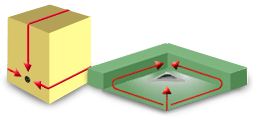An air trap occurs where the melt traps and compresses a bubble of air or gas between two or more converging flow fronts, or between the flow front and the cavity wall. Typically, the result is a small hole or a blemish on the surface of the part. In extreme cases, the compression increases the temperature to a level that causes the plastic to degrade or burn.
Air traps are often due to converging flow fronts caused by racetrack or hesitation effects, or by non-uniform or non-linear fill patterns. Even when the part has balanced flow paths, inadequate venting can cause air traps to occur at the ends of flow paths.
For a Dual Domain model, the Air traps result shows a thin, continuous line wherever an air trap is likely to occur. For 3D models, it displays a solid colored area wherever an air trap is likely to occur.

Using this result
The Air traps result shows how severe air traps will be and where they are likely to occur on the part. Air traps may be acceptable if they occur on a surface that does not have to be visually perfect .
The Fill time result is used in conjunction with the Air traps result to confirm the filling behavior and assess the likelihood of air traps appearing.
The air trap plot is used to determine the probability of an air trap occurring at a particular location. A higher value indicates a higher probability that an air trap will occur, and a lower value indicates a lower probability that an air trap will occur.
- Burn marks caused by air in an air trap, which ignites under pressure and burns the plastic.
- Short shots caused by the incomplete filling of the part; if an air trap is not vented and not compressed quickly enough to cause a burn mark, it may cause a short shot or leave bubbles of air or gas in the plastic part.
- Other surface blemishes caused by air traps.
Things to look for
- Use flow leaders or deflectors.
- Increase the injection speed to eliminate air traps caused by converging flow fronts and hesitation.
- Decrease the injection speed to reduce air traps caused by poor venting, and to prevent burn marks.
- Decrease the part wall thickness ratio to reduce racetracking.
- Move the injection locations so that the air traps form in areas that are easy to vent, such as the parting plane.